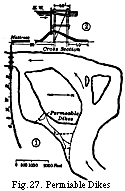 |
 |
Permeable Dikes, instead of entirely cutting off or diverting the current flow, merely slacken and retard it. They consist of open work construction, usually of timber piles and cribbing with rubble weighted brushwood mattress work hurdles. The velocity of the current being retarded behind or between such dikes, material in suspension is deposited and the area is filled up until the dikes themselves eventually become buried in a hydraulic fill of their own creation. On account of the initial increase in velocity at the contracted area of the dike itself, the mattress work is built with an apron on each side of the work to prevent scouring and undermining. |